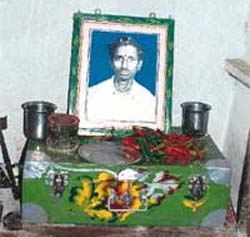Abetment to suicide
 the grim reaper has had a successful harvest. Death has walked through the village on padded feet, as did the pests in the fields. The dying crop whispers a dirge for the body of Kaselte Sammiah, a poor cotton farmer who committed suicide in village Sitarampur of Parkal division in district Warangal, Andhra Pradesh (ap), on February 2, 1998. The villagers bear witness to what has been the fate of at least 80 farmers in the state since June 1997. Survived by seven children, Sammiah died on February 1 after consuming half-a-litre of monocrotophos - a pesticide that failed to protect his cotton crop from the pest ladde paguru (Spodoptera litura). He was under a whopping debt of Rs 1,40,000.
the grim reaper has had a successful harvest. Death has walked through the village on padded feet, as did the pests in the fields. The dying crop whispers a dirge for the body of Kaselte Sammiah, a poor cotton farmer who committed suicide in village Sitarampur of Parkal division in district Warangal, Andhra Pradesh (ap), on February 2, 1998. The villagers bear witness to what has been the fate of at least 80 farmers in the state since June 1997. Survived by seven children, Sammiah died on February 1 after consuming half-a-litre of monocrotophos - a pesticide that failed to protect his cotton crop from the pest ladde paguru (Spodoptera litura). He was under a whopping debt of Rs 1,40,000.
In the last 24 hours, no government official has visited the area as most of them are either busy with the elections or with field surveys.Tension mounts as the Down To Earth team approaches the village at about 8:00 pm. The anger in the eyes of those gathered is clearly visible as they mistake the team for local government officials. It was very difficult for them to get Sammiah's body from the hospital as no official was there to complete the paperwork.
"Since the beginning of the new year, not a single day has passed without one cotton farmer committing suicide," says a farmer in Warangal. Almost the entire standing cotton crop has been devastated in the district and communities are on the brink of starvation if relief is not provided immediately by the government.
As the toll rises, politicians are capitalising on the situation to score over each other as the elections approach. The Union and state governments are too busy passing the buck to each other. The issue of compen-sation for the failure of the cotton crop - especially to the families of the dead farmers - has acquired a political colour that mocks the human tragedy. Political parties are eager to blame each other in the election rallies. The ultimate jolt came on February 3, 1998, when Mutyalapali Subbaiah, a farmer from district Prakasam, attempted suicide in front of the chief minister Chandrababu Naidu at an election rally in Markapur. He survived. Suicides due to failure of crops are not uncommon in this part of the country - cotton farmers have been a neglected lot and are invariably under heavy accumulated debt.
But the problem has been complicated this season by pests in general and pesticides in particular. Indiscriminate application of pesticides has led to resistance in pests and a solution to the problem does not seem possible.
Faced with a raging attack, first by S litura and then by another pest, Heliothis armigera (American bollworm) on the cotton crop, up to their neck in debt and cultivating on leased agricultural land, frantic farmers in ap were sitting ducks for pesticide suppliers ready with spurious pesticides to be distributed on credit. While pests continued to ravage crops, expenses mounted and the noose tightened. What followed was a spate of suicides.
On January 7, the Union cabinet decided that destruction of crop due to large-scale pest attack will henceforth be treated as "national calamity" for the purpose of extending relief to farmers in the form of dole. This amounts to a humiliating acceptance of the failure of crop science, blaming nature for human mismanagement. In effect, the various agricultural research institutions of the Union and state agriculture departments - with their extension workers and pest surveillance - have been proved to be redundant. Pest attacks have become the rule rather than the exception in Indian agriculture. They cause yield losses ranging from 10 per cent to 30 per cent, according to A K Raheja, deputy director general, and G C Tewari, principal scientist, of the Indian Council of Agriculture Re-search (icar). And frenzied farmers are regularly resorting to indiscriminate use of pesticides under the lack of proper education from government agencies.
